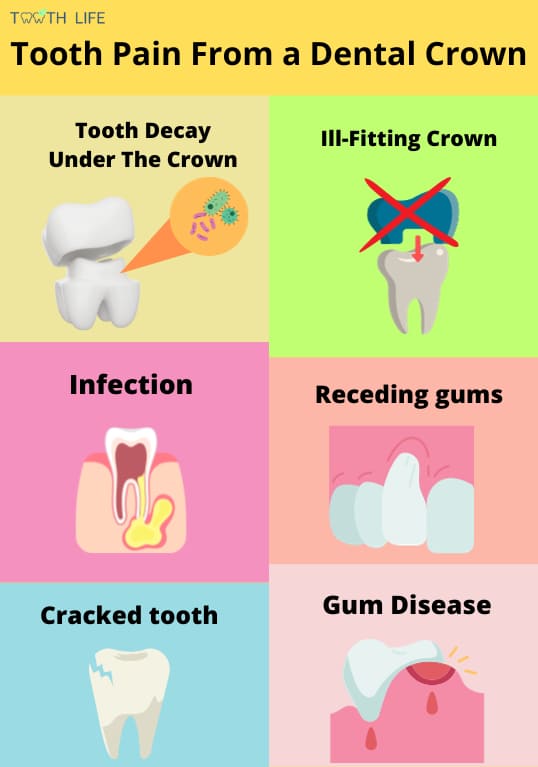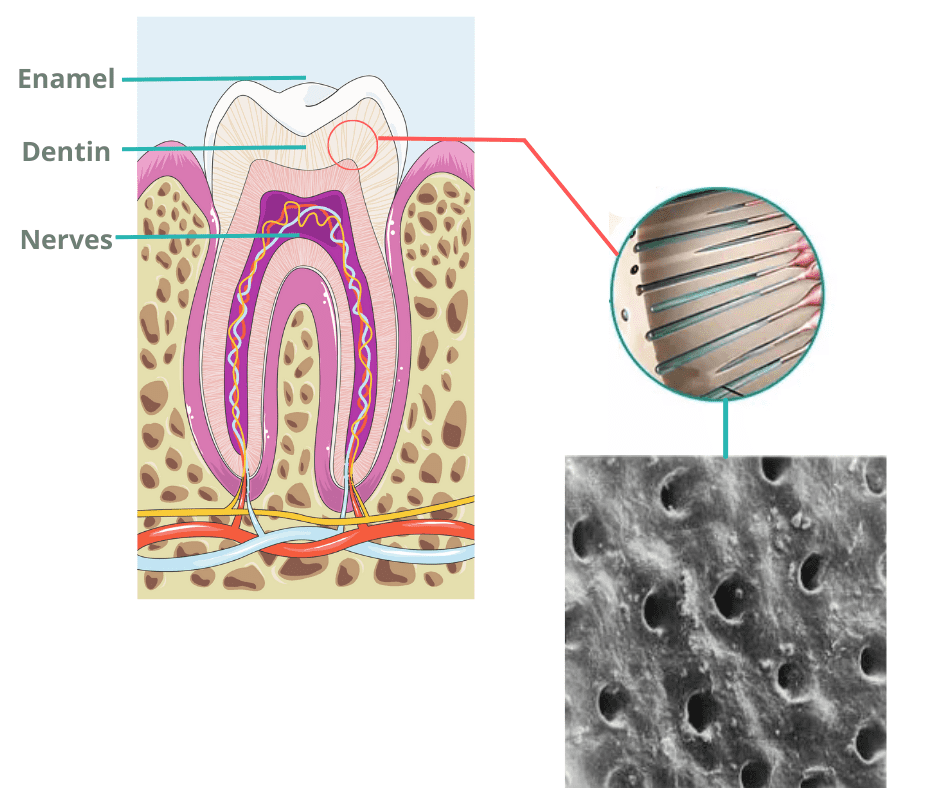Why does a temporary crown often bring pain?
 As your tooth becomes severely damaged to the point that it can no longer support a filling, your dentist may suggest a crown to restore and protect it.
As your tooth becomes severely damaged to the point that it can no longer support a filling, your dentist may suggest a crown to restore and protect it.
However, this does not come without a cost. Often, the pain comes right after you receive your temporary crown.
Find out in this article whether your pain is normal or not, the possible complications, and how to manage them while waiting for your permanent crown.
Table of content
What happens to the tooth when it receives a temporary crown?
Before placing a crown, your dentist must first trim the tooth so that the crown can fit.But before you can tell whether the pain you're feeling is normal, you need first to understand the structure of your teeth. They're made of two hard layers: enamel and dentin.

Enamel is the outermost layer and hardest tissue of our body, while dentin is softer and lies beneath it.
After trimming the tooth, the entire enamel layer is usually removed, leaving only a layer of dentin, which separates the nerves from the outside environment.
The problem is that dentin isn’t as protective as enamel. It’s not impermeable and contains thousands of tiny channels called dentinal tubules, which can allow bacteria to reach the tooth’s nerves more easily. In fact, there are about 18,000 to 21,000 tubules per square millimeter of dentin (1).
Once the dentin is exposed, your tooth becomes more sensitive to things like hot and cold foods. That’s why a well-fitting temporary crown is so important—it helps protect the nerves and prevent discomfort.
If the crown doesn’t fully cover the tooth, saliva and bacteria can seep in through the dentin. The result? Pain that gets worse when eating or drinking something hot or cold.
This, of course, happens only when the tooth is still alive (meaning it hasn’t had a root canal yet).
Even with a well-made temporary crown that fully protects the tooth, you might still feel some pain. That’s because the drilling process can overheat the tooth and irritate the nerves. This often leads to temporary inflammation that you may notice once the numbness wears off. But this usually resolves on its own.
When is pain from a temporary crown normal?
After placing a temporary crown, some pain or discomfort should not be a cause for concern. If your tooth is alive (without root canal treatment), you should expect some nerve inflammation following the procedure. This is usually a short-lived reaction that gradually subsides and resolves on its own in a few days.The pain should be mild and should ease once the cause of irritation is gone. But if the pain is strong, constant, lasts too long, or spreads to other areas of your jaw, you should see your dentist—it could be a sign of an infection.
Your gums may also feel a little sore after the procedure. This is because your dentist may have accidentally injured your gums. That's also common and temporary, and your gums will soon return to their normal state.
Many patients report that their crown feels different or that their bite doesn’t feel the same as before. That’s completely normal. It can take up to two weeks for your brain to adjust to the new crown and how your teeth come together when you bite.
However, persistent pain when you bite down is not normal—it could mean the crown is too high.
When is pain from a temporary crown not normal?
The main goal of a temporary crown is to protect the tooth from external irritation and to restore its appearance until the permanent crown is ready.However, in some situations, the temporary crown can be associated with several problems that can cause you abnormal pain and discomfort. These include:
1. Cavities:
When placing a temporary crown, your dentist makes sure there are no cavities or decayed tissue left behind. The crown needs a solid, healthy foundation to sit on. If any decay is left untreated before the crown is cemented, it can lead to ongoing pain, infection, and crown failure.
How it looks like?
If decay is left behind, you might not notice it right away. But over time, you may start to feel persistent pain, especially when eating or drinking cold or acidic foods.
Treatment:
Your dentist will first remove the crown and clean out any decayed tissue.
If the decay is too deep or if there’s a suspicion that the nerve is infected, a root canal treatment may be necessary.
2. The tooth is infected:
If your tooth was previously infected or severely decayed and didn’t undergo a root canal before the crown was placed, the infection will persist or even get worse.
Simply placing a crown won’t clear the infection—the only way to treat it properly is with a root canal.
Even a tooth that has had a root canal can become reinfected, especially if decay remains under the crown or if the crown doesn’t fully cover the tooth, allowing bacteria to enter.
The symptoms to look for:
Symptoms to watch out for include:
- Redness around the crown
- Intense pain radiating to the jaws
- Heat sensation
- Pus discharge around the crown
- Bad breath or unpleasant taste in the mouth
- Gum boil
- A feeling that the tooth is long
Treatment:
An infected tooth will need a root canal treatment. If one has already been done but the infection persists, a retreatment may be needed to give the tooth another chance.
If the root canal treatment fails or the tooth is badely damaged, it might need to be removed.
3. The crown doesn't fit correctly:
If the crown is leaking and leaves gaps where food and bacteria can get in, it can cause sensitivity and pain.
Another common problem is when the crown sits higher than your other teeth. This means it takes more pressure when you bite, leading to discomfort.
If the crown’s shape and size aren’t well designed, it can create gaps between teeth where food gets stuck. This can make the gums between your teeth tender, swollen, and inflamed.
Symptoms to look for:
- Your temporary crown is loose or comes off the tooth
- Sensitivity and discomfort when chewing
- Your bite doesn’t feel right
- Accumulation of food debris between your teeth
- The spaces between the teeth are too wide or too tight
Treatment:
If you think your crown is poorly shaped, talk to your dentist. It may need some adjustments to line up evenly with your other teeth.
4. Extreme sensitivity to hot or cold foods:
If the sensitivity is sharp and doesn’t go away, it may mean that some dentin is exposed. In that case, the crown might need to be redone to cover and protect the exposed dentin.
Other potential causes of your temporary crown pain:
Other causes of pain after a temporary crown include:1. Receding gums:
When the gums pull away from your teeth, they expose the roots to the oral environment. Because the roots are more sensitive, you may start to feel pain when you eat cold, hot, or acidic foods.
2. Sore gums:
Pain or inflammation of the gums surrounding the tooth after the procedure is normal if it lasts a few days. However, if it lasts longer than expected, visit your dentist to rule out any possible infection.
3. Bruxism:
If you have a habit of grinding or clenching your teeth, this is probably the cause of your sensitivity. Clenching and grinding put too much pressure on your teeth, which can wear them down over time.
4. Cracked or broken tooth:
This can also be a potential cause of your pain. After the tooth is trimmed, it becomes more fragile because it has lost some of its supporting structure. This is especially the case if the tooth has had a root canal, which makes the roots weaker and more prone to breaking.
Biting on a hard object is the most common cause of these injuries.
In its early stage, it can be challenging to spot. It usually starts with pain when you bite down or chew. You may also notice a tiny line when you take a closer look at the tooth.
When should you talk to your dentist?
Although most of the time pain is temporary and nothing to worry about, some symptoms may signal a problem.You should see your dentist if you experience any of the following:
- Severe toothache: If you experience intense, stabbing tooth pain, especially without an obvious reason, see your dentist as soon as possible. It could be an infection that needs to be treated rapidly to save the tooth.
- Bleeding or swollen gums: If your gums are bleeding or swollen, it may be a sign of gum disease or, more seriously, an abscess.
- Your crown is loose: If you notice that your crown is loose or not firmly attached to the tooth, it may need to be adjusted or cemented back in place.
- Extreme sensitivity to hot or cold: If your tooth is sensitive to hot or cold foods or drinks, your crown may not completely cover the tooth. This could also be a sign of decay or gum recession. Your dentist will help you identify the real cause and recommend the appropriate treatment.
How to manage the pain from a temporary crown at home?
Here are some tips that can help relieve your discomfort and pain after crown placement:- Over-the-counter pain relievers: Taking over-the-counter pain relievers, such as ibuprofen or acetaminophen, can help reduce pain.
- A mouthguard: If you clench or grind your teeth, wearing a mouthguard can help relieve the pressure on your teeth. This can also prevent other dental conditions, such as tooth wear and gum disease.
- Saltwater rinse: Rinsing your mouth with warm salt water can help to reduce inflammation and promote healing. Dissolve a teaspoon of salt in a cup of warm water and rinse your mouth with the solution for 30 seconds to one minute, then spit it out.
- Baking soda rinse: Baking soda rinse can help to offset acidity in your mouth, reduce inflammation, and soothe pain and discomfort around your crown.
- Avoid hard or sticky foods: To prevent further pain and discomfort, avoid hard or sticky foods that may dislodge the temporary crown or exacerbate the pain. Stick to soft foods and liquids until the pain subsides.
- Apply a cold compress: Applying a cold compress to the affected area can help to reduce swelling and relieve pain. Wrap a bag of ice or a cold pack in a towel and apply it to the cheek near the affected tooth for 10 to 15 minutes at a time.
- Dentin: Structure, Composition and Mineralization https://www.ncbi.nlm.nih.gov/pmc/articles/PMC3360947
- An overview of the dental pulp: its functions and responses to injury https://pubmed.ncbi.nlm.nih.gov/17546858/
- Clinical complications in fixed prosthodontics https://www.sciencedirect.com/science/article/abs/pii/S0022391303002142
- “Parts of the figure were drawn by using pictures from Servier Medical Art. Servier Medical Art by Servier is licensed under a Creative Commons Attribution 3.0 Unported License (https://creativecommons.org/licenses/by/3.0/).”